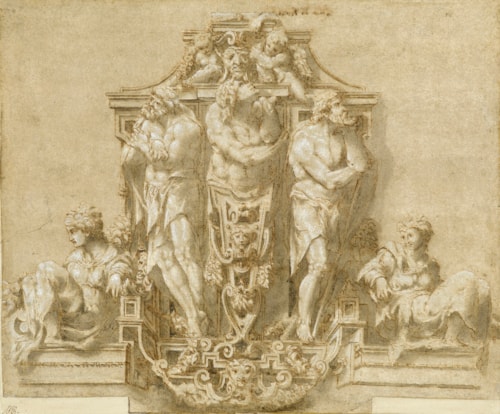
Lelio ORSI
Novellara 1511 - Novellara 1587
Biography
‘Lelio Urso in architectura magno, in pictura majori, et in Delineamentis optimo’, reads the epitaph on the tomb of Lelio Orsi, a provincial painter of considerable talent about whom relatively little is known today. He is not mentioned by Vasari or by any other early sources, and most of his paintings are now lost, save for a few easel pictures and some fresco fragments. The son of a minor painter, Orsi is first recorded in 1536 in Reggio Emilia, where he worked on the design of a triumphal arch to celebrate the entry of Ercole d’Este into the city. He continued to work extensively in Reggio Emilia, decorating the façade of the Torre dell’Orologio there in 1544. By 1546 Orsi was working for the Gonzaga of Novellara, a minor branch of the Mantuan family, who remained his most important patrons throughout his career.
While he may have made a first visit to Rome some time in the late 1540’s, he was definitively in the city from 1554 to 1555, and it was here that the influence of Michelangelo was added to the dominant early influence of Correggio, effecting a profound change in Orsi’s style. Throughout the 1560’s he continued to work for the Gonzaga of Novellara, decorating their villa at Bagnolo and providing frescoes for the villas of the Casino di Sotto and the Casino di Sopra, as well as the Rocca di Novellara; unfortunately very little survives of any of these large-scale decorative projects. In 1563 Alfonso Gonzaga decreed that all the houses in Novellara should be decorated with facade frescoes, and Orsi was given the responsibility of designing and executing several of these, including for his own home. A number of drawings by Orsi for such facade and wall decorations are known, although for the most part the frescoes themselves do not.
As only fragments of his mural paintings survive, Orsi’s style as a painter is best seen in a small number of cabinet pictures of mythological and religious subjects that he produced; works which show the continued influence of Michelangelo, Correggio and the studio of Raphael. Little is known of Orsi’s activity in the last fifteen years of his career, which are thought to have been spent working in Reggio Emilia before his death in Novellara at the age of seventy-six.
Lelio Orsi’s drawings – many of which are designs for wall or façade decorations - have survived in greater number than his paintings, and were highly regarded in his lifetime. Often displaying the particular influence of Michelangelo, Orsi’s drawings are characterized by a refined technique and an imaginative approach to composition. The inventories of the Gonzaga collections at Novellara list several sheets by the artist, and enough contemporary copies of his drawings exist to show that they were widely known and appreciated. In later years the 18th century French collector and connoisseur Pierre-Jean Mariette noted how Orsi’s drawings were popular with collectors, writing that ‘les desseins de ce peintre sont fort recherchés. Il a une assez belle plume, et joint au goût terrible de Michel-Ange les graces aimables du Corrège’. Significant collections of drawings by Lelio Orsi are today to be found in the British Museum, the Louvre, the Uffizi and the Royal Collection at Windsor Castle.




